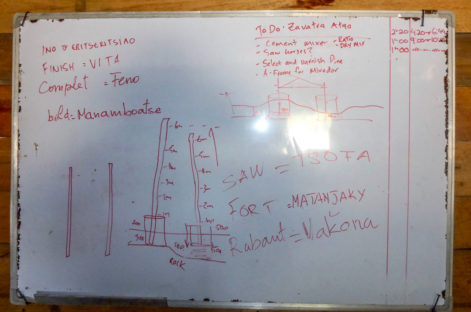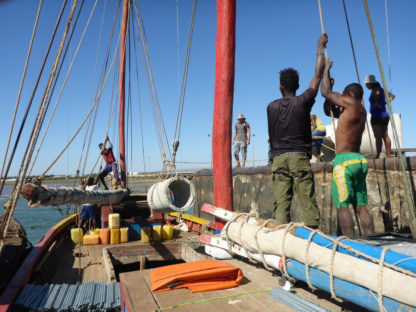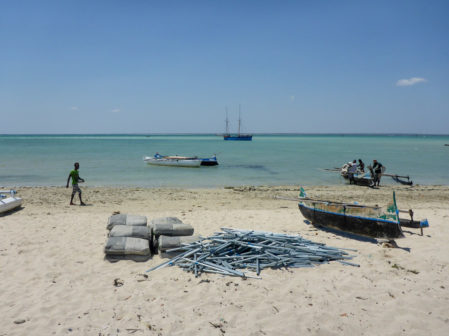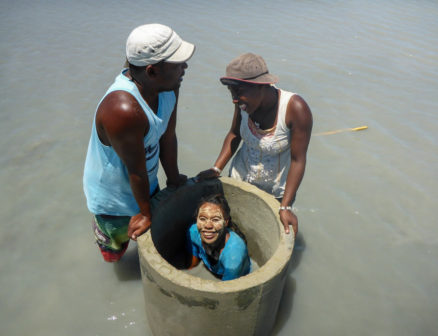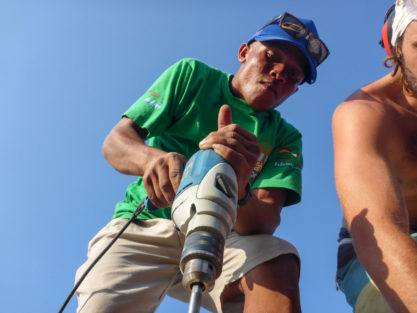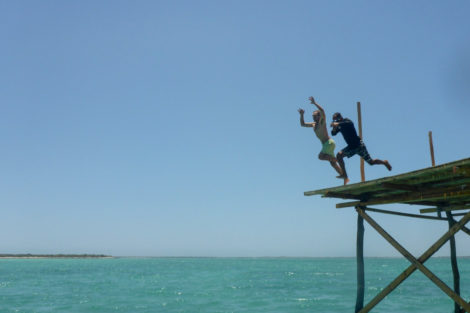It’s early morning in Tampolove, and crowds are beginning to gather to sip coffee and nibble on freshly baked Malagasy doughnuts, just in time for “masoandro abony” (the rising of the day’s eye). Conversation jumps from yesterday’s events to today’s plans, but there is another subject which seems to be coming up often. The newly completed “Mama Be”, which stands proudly above the rising tides and over 800 metres from shore, has been a hot topic in Tampolove and the surrounding communities for some time, and rightly so!
Read about how aquaculture has affected the lives of Vezo fishers in southwest Madagascar.
Tampolove is a small fishing village on Madagascar’s southwest coastline, tucked between the inland Spiny Forest and the protected water of the Bay of Assassins. It is also situated within the protected waters of the Velondriake Locally Managed Marine Area (LMMA), the first of its kind in Madagascar. The Bay of Assassins, with its sheltered and shallow waters, is also home to Blue Ventures’ Aquaculture Development Hub, where over the past 8 years non-extractive and sustainable livelihoods opportunities have been innovated and evolved.
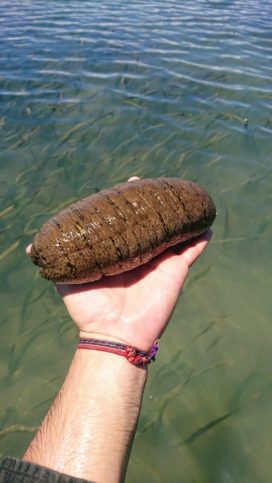
Zanga foty (Holothuria scabra) | Photo: Tim Kluckow
Sea cucumbers, known here as “zanga”, or as “dingadigana” in the northwest, are a highly valuable seafood product, and their dried and processed form (called beche-de-mer) has been increasingly in demand on the international market.
Unfortunately this growing demand has led to intense fishing pressure on the local zanga stocks in the region, and wild stocks of this animal are now extremely threatened. This in turns threatens the livelihoods of those who rely on the sale of these animals to support themselves and their families. Blue Ventures has been working since 2009 to address this situation, and currently over 100 fishermen and women in Tampolove have been working alongside our aquaculture team to develop a novel livelihood that not only re-populates the the sheltered water of Bay of Assassins with released juvenile zanga, but also allows a steady monthly income through the sales of the mature adults.
After a project-wide assessment in 2016, and much discussion between BV and Tampolove farmers and residents, it was evident that security was a major issue. Opportunistic thieves from neighboring villages would sneak into the pens at night and steal the farmers’ zanga stock right before they were due to sell them!
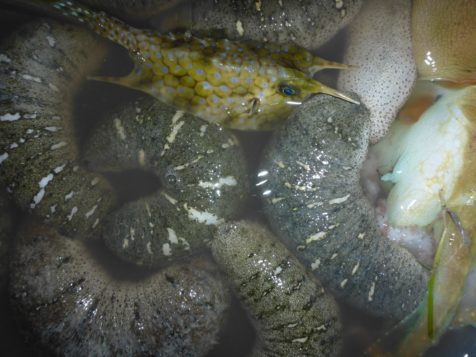
Bucket of Zanga stolen from farmers’ pens | Photo: Angelo Donah
A plan of action to tackle theft was made – and part of this plan included the decision to construct a security tower within the farming area that was sufficiently equipped to allow farmers to spot thieves before they could approach their stock. This new structure was to be big, bold, and beautiful, and will hopefully work to prevent the theft of sea cucumbers in the future. She would be aptly named Mama Bevata, or Big Mama in the Vezo language.
Mama Bevata began in the city of Toliara, 150km south of Tampolove, where preliminary sketches and planning sessions confirmed the design, before all 4 tonnes of material needed for construction were procured from various quincailleries (hardware store), timber mills and back-alley blacksmiths. These materials then made their way up the Mozambique Channel within the hold of a 20 year old Malagasy cargo boat called the Soa Avao!, meaning Only Good!, which we certainly thought was a fitting name.
The Soa Avao! made a grand sunset entrance into Tampolove to a crowd that had gathered on the beach very interested to see what was being delivered. The journey was a snappy day and a half due to a steady Tsioke Atsimo (South wind), and an experienced crew that knew how to harness the power of this gusting and mighty force. The next day it seemed like all of Tampolove was on hand to help bring the materials and tools off Soa Avoa! and store it all in our aquaculture building that serves as workshop, storeroom, community meeting place and boxing gym (over the weekends!).
Four large concrete manholes (bij) were bought to use as foundations for the security tower, and these were by far the hardest to get out of the boat, requiring about 15 on the end of a rope to slowly lower them, to this day they still have some of the boats paintworks smeared on their side, sorry Soa Avao!. These were left in the bay and at low tide each one was rolled into place in the middle of Zanga Aquaculture Zone. A fomba (traditional ceremony) was performed by the community elders of Tampolove, to ask the forefathers and mothers for their blessing and for good fortune on Mama Bevata and the Zanga farms. Rum and Fanta were poured into each of the bij foundations and the construction of Mama Bevata could officially begin.
Over the next couple of months, aquaculture technicians were trained in how to operate power tools safely, and the team quickly built two large 5 metre A-frames. Technicians, farmers and even the resident dogs hauled the large A-frames out to the farms, and with the help of passing Blue Venture volunteers, the frames were pulled up. Excitement was in the air as Mama Bevata towered over the vacant farming area, and before long, a 5*5 metre platform was built 6 metres off the ground. This was quickly followed by a hatch door and ladder.
With the start of a new year came new walls, new railing and a new Vondro roof. By the end of June, Mama Bevata was kitted out with a solar panel system, lights and a siren. Excited farmers could now climb up and look down on the farms they had been busy building over the last 6 months and see how the new model was going to improve their farming. With the larger space now available on the security tower, security guard duties would now involve more than one guard and farmers were more than willing to put their hands up to volunteer for security watches – some even volunteering to live permanently on the tower!
Today the morning chat over coffee is all about her, but soon enough there will be much more for Tampolove to talk about. With the completion of the new zanga farming model imminent, farmers in Tampolove will soon once again be stocking their farms with hundreds of juvenile zanga, ready to mature into a valuable and reliable source of income, whilst also repopulating the Bay of Assassins with the juveniles they release before being harvested. The difference this time, is that farmers will now be able to sleep easy knowing their stock is protected, those who are not on guard duty that is!
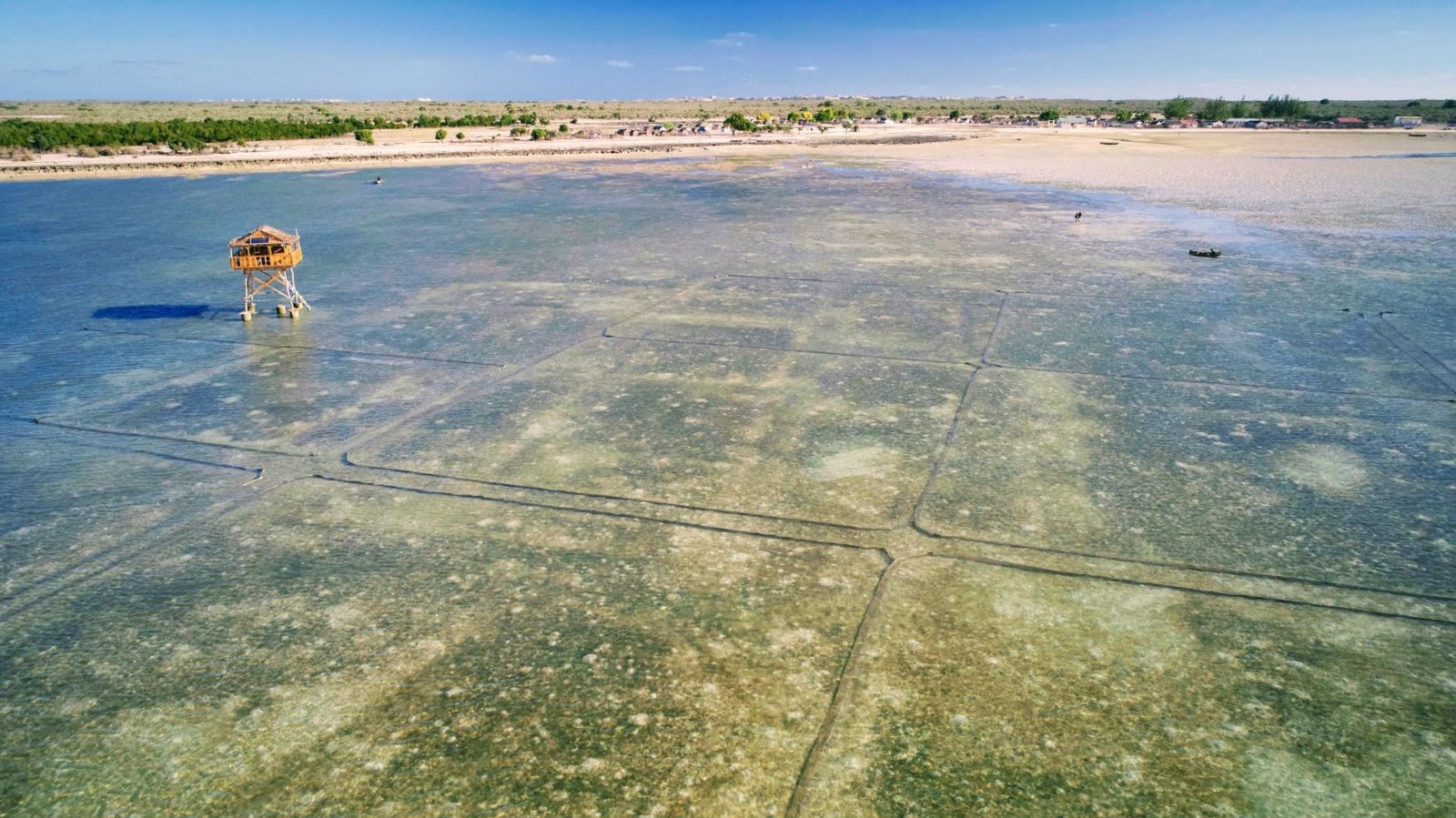
The finished Mama Bevata stands proudly amongst the sea cucumber pens | Photo: Tim Kluckow
Thanks to our development partner Norges Vel for financial and technical assistance with this project, as well as to our local commercial partner Indian Ocean Trepang.


